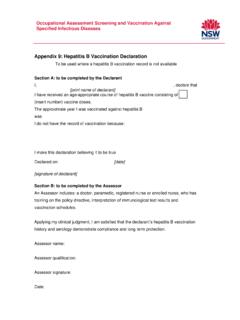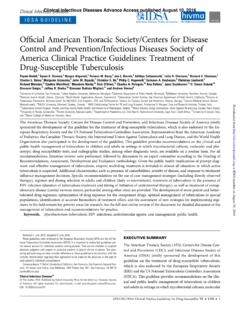Transcription of Bloodborne Pathogens - Occupational Safety and Health ...
1 Bloodborne Pathogens Bloodborne Pathogens are microorganisms that are transmitted through the bloodstream. The viruses that cause hepatitis B Virus (HBV) and Human Immuno-deficiency Virus (HIV) are two examples of Bloodborne Pathogens . For a Bloodborne pathogen to be spread, the bodily fluids of an infected person must enter into the bloodstream of another person. The most common cause of transmission in the workplace is when an infected person s blood enters another person s bloodstream through an open wound. Occupational Exposure The Occupational Safety and Health Administration (OSHA) standard 29 CFR (c)(1)(i) states that Each employer having an employee(s) with Occupational exposure as defined by paragraph (b) of this section shall establish a written Exposure Control Plan designed to eliminate or minimize employee exposure. Occupational exposure, as defined by paragraph (b), is reasonably anticipated skin, eye, mucous membrane, or parenteral contact with blood or other potentially infectious materials that may result from the performance of an employee s duties.
2 There are good reasons to provide workers with a Safety training program about Bloodborne Pathogens . First, anybody can be exposed during an accident or even from close contact with someone who has an open sore. Second, OSHA has cited contractors for failing to provide education in this area, specifically when employees are required to be certified in first aid/CPR. And third, business-owned facilities, such as shops and offices, are covered under the general industry regulations and therefore subject to OSHA s Bloodborne pathogen standard. In addition, OSHA s General Duty Clause states: Section 5.(a) Each employer (1) shall furnish to each of his employees employment and a place of employment which are free from recognized hazards that are causing or are likely to cause death or serious physical harm to his employees; (2) shall comply with Occupational Safety and Health standards promulgated under this Act.
3 (b) Each employee shall comply with Occupational Safety and Health standards and all rules, regulations, and orders issued pursuant to this Act which are applicable to his own actions and conduct. Section 5(a)(1) clearly states the employer s responsibility to eliminate all workplace hazards. If any employee is required to be certified in first aid, he or she may very well be considered to have an Occupational exposure. If first aid or CPR certification is not required, it is possible that Occupational exposure to Bloodborne Pathogens is not present; however, it is still to an employer s benefit to provide training and have a written exposure plan addressing Bloodborne Pathogens . Not only will employees be made aware of potentially critical information, but complicated arguments over the interpretation of general duty will be avoided, as well. Again, all areas of a company s business and all personnel should be considered when preparing an exposure control plan.
4 Clerical and office personnel, as well as any janitorial staff, should be included, with all the various employees duties taken into account. Definitions Following are some terms that appear in this section that are critical to the understanding of Bloodborne Pathogens . Bloodborne Pathogens : Microorganisms that are present in human blood and can cause disease in humans. These Pathogens include, but are not limited to, HBV and HIV. engineering controls: Controls that isolate or remove Bloodborne Pathogens from the workplace. exposure incident: A specific eye, mouth, other mucous membrane, nonintact skin, or parenteral contact with blood or other potentially infectious materials that result from the performance of an employee s duties. hepatitis B Virus (HBV): The most common form of hepatitis ; a liver disease that initially causes inflammation of the liver and frequently leads to more serious conditions, including cirrhosis and liver cancer.
5 HBV is usually transmitted through mucous membranes or breaks in the skin. After exposure, it can take two to six months for HBV to develop. The initial symptoms of HBV infection are like those of a mild case of the flu: fatigue, stomach pain, loss of appetite and nausea. As the disease progresses, jaundice (yellowing of the skin) and darkened urine will occur. Although there is no cure, vaccination directly after contact (well before symptoms appear) can prevent infection. human Immunodeficiency Virus(HIV): A Bloodborne pathogen that attacks the immune system. Symptoms of HIV can include weakness, fever, sore throat, nausea, headaches, diarrhea and some forms of cancer. Many people can go years before showing any symptoms. HIV eventually may lead to Acquired Immune Deficiency Syndrome (AIDS) and the breakdown of the immune system. Currently, there is no vaccination against HIV and no proven cure.
6 However, there have been some major breakthroughs in recent years in controlling HIV and significantly delaying the onset of AIDS. other potentially infectious materials: (1) Human body fluids, including semen, vaginal secretions, cerebrospinal fluid; any body fluid that is visibly contaminated with blood; and any combination of body fluids. (2) Any unfixed tissue or organ (other than intact skin) from a human (living or dead). source individual: Any person, living or dead, whose blood or other potentially infectious materials may be a source of Occupational exposure to an employee. In the construction industry, source individuals are mainly limited to trauma victims. universal precautions: Treating all human blood and body fluids as though they are known to be infectious for HIV, HBV and other Bloodborne Pathogens . workplace Controls: Controls that reduce the likelihood of exposure by altering the manner in which a task is performed.
7 Training Program Minimum Standards Materials must be in a language common to employees and appropriate in content and vocabulary to their educational and literacy levels. The training program needs to contain, at a minimum, the following elements: A general explanation of the epidemiology and symptoms of Bloodborne diseases An explanation of the modes of transmission of Bloodborne Pathogens An explanation of the employer s exposure control plan and the means by which the employee can obtain a copy of the plan An explanation of how to recognize activities that may involve exposure to blood and other potentially infectious material An explanation of the use and limitations of methods that will prevent or reduce exposure, including appropriate engineering controls, work practices and personal protective equipment (PPE) Information on the types, proper use, location, removal, handling, decontamination and disposal of PPE An explanation of the basis for selecting PPE Information on the efficacy, Safety , benefits and method of administration of the hepatitis B vaccine, and its availability, free of charge, to employees with an Occupational hazard exposure Information on the appropriate actions to take and people to contact in an emergency involving blood or other potentially infectious material An explanation of the procedure to follow if an exposure incident occurs, including the method of reporting the incident and the medical follow-up that will be made available Information on the post-exposure evaluation and follow-up that the employer is required to provide for the employee following an exposure incident An explanation of the signs and labels and/or color coding required by 29 CFR (g)(1)
8 An opportunity for questions and answers with the person conducting the training session An accessible copy of the regulatory text of this standard and an explanation of its contents The person conducting the training must be knowledgeable in the subject matter and understand the Bloodborne pathogen program as it relates to the roofing business. Exposure Control Plan The National Roofing Contractors Association (NRCA) has put together a Bloodborne Pathogens compliance program to assist contractors in complying with the OSHA regulations. This sample program can be found at the end of this chapter. If a contractor does not currently have a written plan, this outline can be used to develop one. Even if the business does not have a shop, office staff or company-employed janitorial staff, it is prudent to implement a plan appropriate to the organization, not only to avoid potentially costly fines but also to increase employee awareness by providing an explanation of the OSHA regulatory requirements.
9 A contractor should be careful not to just copy this plan and put it in the file cabinet. A plan should be tailored specifically to a business. Once a plan is adapted, a contractor is responsible for knowing what is in it and implementing it as written. Sample Program Exposure Determination Although there is not a large risk of exposure in the roofing industry, [company name] has tried to identify exposure situations that employees may encounter. The following page lists all employees with any reasonable potential for exposure, their titles and the reasons they may find themselves in an exposure situation. For example, all supervisors who are trained in first aid and may have an Occupational exposure in the event of an accident are listed. The initial list was compiled on or before _____. (Date) _____ will work with department managers and supervisors to revise and (Employee Name) update these lists as our tasks, procedures and classifications change.
10 Work Activities Involving Potential Exposure to Bloodborne Pathogens Listed below are the names, titles and job responsibilities that may bring these individuals into contact with human blood or other potentially infectious materials, which may result in exposure to Bloodborne Pathogens : Name Title Job Responsibilities _____ _____ _____ _____ _____ _____ _____ _____ _____ _____ _____ _____ _____ _____ _____ _____ _____ _____ _____ _____ _____ _____ _____ _____ _____ _____ _____ _____ _____ _____ _____ _____ _____ _____ _____ _____ _____ _____ _____ _____ _____ _____ _____ _____ _____ _____ _____ _____ _____ _____ _____ _____ _____ _____ _____ _____ _____ _____ _____ _____ _____ _____ _____ _____ _____ _____ _____ _____ _____ _____ _____ _____ _____ _____ _____ _____ _____ _____ _____ _____ _____ _____ _____ _____ _____ _____ _____ _____ _____ _____ _____ _____ _____ _____ _____ _____ _____ _____ _____ _____















